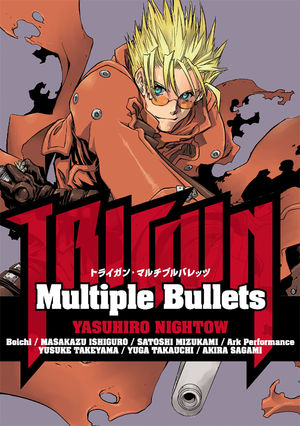 “Trigun†has two types of fans. the ones that love it until the ending. And the others who love it in spite of the ending. Such is the case with “Trigun: Multiple Bullets,†a collection of comics that take place in different times during “Trigun.†While it hits the sweet spot some places, it misses completely in others.
“Trigun†has two types of fans. the ones that love it until the ending. And the others who love it in spite of the ending. Such is the case with “Trigun: Multiple Bullets,†a collection of comics that take place in different times during “Trigun.†While it hits the sweet spot some places, it misses completely in others.
The first story is a two-parter by Yasuhiro Nightow called “Trigun: Badlands Rumble-Extra: Showdown with the Dodongo Brothers in Honeycombed Village.†Here, Vash and co. are called in to help a village that’s been rampaged by the Dodongo Brothers. What ensues is one big gunfight after another. It’s pretty exiting with “Trigun’s†usual comedy thrown in for good measure. The problem is the ending leaves something to be desired. The art also looks like it was drawn by a novice who attempted drawing manga for the first time.
“Trigun: The Lost Plant†by Boichi shows Vash way before he was “The $$60 Billion Man.†Here, he is asked by a plant to kill its child, one which will destroy the universe if born. The problem, as any fan knows, is that Vash never kills. The story itself and its conclusion is one of the better stories in this collection. Here, we see Vash, who normally has the mental capacity of a seven-year, do some complex thinking to fix the problem. The artwork is also the best out of the bunch. Boichi uses some intensive forms to make some stunning art. The first few color pages are poster quality.
“Denizens of the Sand Planet,†by Satoshi Mizukami is about Zaj, the “Chief of the Worms†and Tran, an “angel’ (plant, actually) who wonder from town to town to determine if humans, plants and worms can coexist with each other. This is one of those philosophical themes found in “Trigun†that easily resolves itself at the end of the story. The characters of Zaj and Tran are interesting even though nothing happens in the story.
“Ark Performance†by Les Enfants is a weird one. It’s not a comic; it’s a story with pencil illustrations thrown in. The story reads like a telling of the legend of Vash and Wolfwood. It’s a decent “legend†and well narrated in the way it should, in these typical legend crawls. The illustrations also look like your typical sacred drawings that show up as part of these legends.
Another weird one is “Mil/Mer TV†by Yuga Takauchi. Milly and Meryl have a TV show and they spend most of the comic trying to waste time because Vash bailed on them. The comic is drawn in the Yonkoma (vertical four panel) style which is perfect for this story. It’s off the wall funny and, along with the cute but funny art style, will make you laugh.
“Raijin (Thunder God): Rising†by Yusuke Takeyama seems way out of place. A Samurai named Rai is protecting a village tries to teach a young boy his way of fighting to protect him and his sister. Despite the decent story and great art, this really has nothing to do with “Trigun.â€
Finally there’s “Cutting is Fighting†by Akira Sagami. It’s a comedy routine where Meryl tries everything to cut Vash’s hair. That’s really it. This has cheap laugh written all over it and you will give Sagami one. What’s funnier is that he put a ton of effort into his pencil style art that looks fabulous.
“Trigun: Multiple Bullets†has plenty of interesting stories and great art to offer despite some misses here and there. “Trigun†fans will devour this collection in an instant while casual readers will still find plenty to enjoy.

Leave a Reply